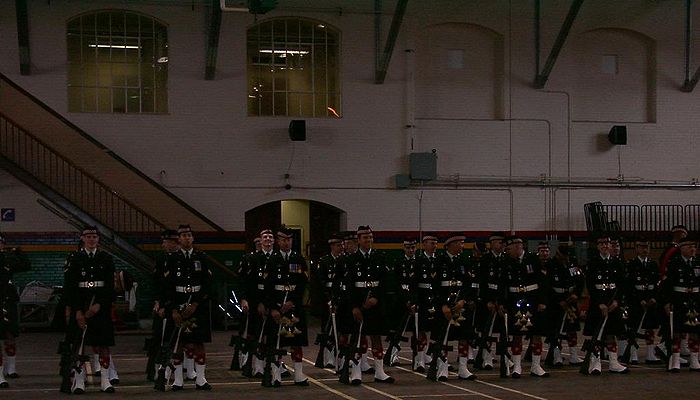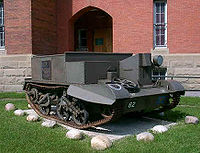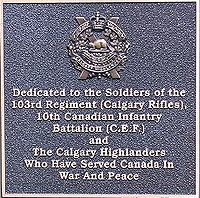
Mewata Armouries
Encyclopedia
Mewata Armoury is a Canadian Forces
Canadian Forces
The Canadian Forces , officially the Canadian Armed Forces , are the unified armed forces of Canada, as constituted by the National Defence Act, which states: "The Canadian Forces are the armed forces of Her Majesty raised by Canada and consist of one Service called the Canadian Armed Forces."...
reserve armoury
Armory (military)
An armory or armoury is a place where arms and ammunition are made, maintained and repaired, stored, issued to authorized users, or any combination of those...
in Calgary, Alberta.
The building was built between 1915 and 1918 for an original cost of $282,051 Canadian dollars. The building was designed by T.W. Fuller (Department of Public Works
Public Works and Government Services Canada
Public Works and Government Services Canada is the department of the government of Canada with responsibility for the government's internal servicing and administration....
Architect) and the project was supervised locally by Calgary architect Leo Dowler. The structure was actually built by A.G. Creelman Co. of Vancouver
Vancouver
Vancouver is a coastal seaport city on the mainland of British Columbia, Canada. It is the hub of Greater Vancouver, which, with over 2.3 million residents, is the third most populous metropolitan area in the country,...
.
The building is located at 801 11th Street S.W. and is still home to local Militia units, chiefly the Calgary Highlanders, and The King's Own Calgary Regiment.
Construction materials
The building has a cut stone foundation with a structure of red brick (common bond with steel reinforcement) and sandstone. The drill hall is significant for the large uninterrupted span of its steel trusses. A second story on the west side was added some time after original construction.Architectural style
The building was designed in a TudorTudor style architecture
The Tudor architectural style is the final development of medieval architecture during the Tudor period and even beyond, for conservative college patrons...
/Gothic Revival style. A classic example of armoury design, Mewata has features deliberately bringing to mind a medieval fortress or castle, including four square corner towers, four smaller six sided towers, and buttresses with turrets and a crenellated roofline.

Original interior details
The original design featured a large central drill hall with 117 rooms (two storeys of soldiers quarters) arranged around its perimeter. The basement included bowling alleys and 30 yard shooting ranges. The facility also included officers' and sergeants' billiard rooms. Barracks have been altered in recent years to serve as offices and storage space. A catwalk around the drill hall has been enclosed on the north and south sides, as well as part of the east side, leaving a short "balcony" overlooking the parade square.Historical highlights
Mewata is a Cree wordCree language
Cree is an Algonquian language spoken by approximately 117,000 people across Canada, from the Northwest Territories and Alberta to Labrador, making it the aboriginal language with the highest number of speakers in Canada. It is also spoken in the U.S. state of Montana...
meaning "O Be Joyful".
Construction began September 24, 1915 and according to some sources was held up by lack of bricks. Two brick factories, one in Redcliff
Redcliff, Alberta
Redcliff is a town in southern Alberta, Canada within Cypress County. Bordering the City of Medicine Hat to the south and east, the town is bisected by Highway 1 and is located on the north bank of the South Saskatchewan River....
and one in Montgomery were built for the specific purpose of providing the bricks to complete the project. The building was completed in 1917. During the Second World War, several wooden huts were built to accommodate the large number of Calgary soldiers mobilized for the Canadian Active Service Force.
In 1939, a large recreation hall was built adjacent to the armouries but the hall burnt down in 1941.
The armoury for a time was home to a Permanent Force squadron of Lord Strathcona's Horse, but is most commonly associated with the Militia units in Calgary. Over the years, several units have been based at Mewata including South Alberta Light Horse, 19th Alberta Dragoons, King's Own Calgary Regiment, the Calgary Highlanders, and 746 Communications Squadron.
During the First World War, Mewata was used as an induction and training centre and a demobilization depot for returning soldiers.
In addition to military uses, other groups and organizations have always used the armoury including a military ball for the Prince of Wales in 1919, the scene of a verbal confrontation between William Aberhart and Major Douglas founder of Social Credit. The Calgary City Police and Calgary Fire Department have often used it for training purposes. In 1975 prior to the Grey Cup
Grey Cup
The Grey Cup is both the name of the championship of the Canadian Football League and the name of the trophy awarded to the victorious team. It is Canada's largest annual sports and television event, regularly drawing a Canadian viewing audience of about 3 to 4 million individuals...
parade twenty marching bands were marshalled in the drill hall.
The building was declared a Provincial Historic Resource on 11 November 1979, a Federal Heritage Building in 1984, and a National Historic Site on 11 May 1991, only the fourth building in Calgary to receive a national designation.
Lodger units
The armoury is currently home to:- The King's Own Calgary Regiment
- The Calgary HighlandersThe Calgary HighlandersThe Calgary Highlanders is a Canadian Forces Land Force Primary Reserve infantry regiment, headquartered at Mewata Armouries in Calgary, Alberta, Canada...
- Regimental Pipes and Drums of The Calgary HighlandersRegimental Pipes and Drums of The Calgary HighlandersThe Regimental Pipes and Drums of The Calgary Highlanders is an authorized volunteer pipe band associated with The Calgary Highlanders of the Canadian Forces. For many years, the band was a bona fide, and separate, military unit unto itself, with a separate Unit Identification Code within the CF...
- 41 Brigade Battle School (South) [formerly Militia Training Detachment Calgary]
- Various cadet units, including 2137 (The Calgary Highlanders) Royal Canadian Army Cadet Corps and 604 "Moose" Squadron, Royal Canadian Air Cadets


Monuments


41 Canadian Brigade Group
41 Canadian Brigade Group is a brigade group that is part of Land Forces Western Area of the Canadian Army. It is a reserve formation and is headquartered in Calgary, Alberta, at the former location of CFB Calgary....
to place a vehicle in front of Mewata Armoury, after discussions in the Museum in 1997. This form of homage is common in other armouries and military bases across Canada. Lieutenant King sought out collectors in order to obtain an appropriate vehicle, and negotiations with the Canadian War Museum
Canadian War Museum
The Canadian War Museum is Canada’s national museum of military history. Located in Ottawa, Ontario, the museum covers all facets of Canada’s military past, from the first recorded instances of death by armed violence in Canadian history several thousand years ago to the country’s most recent...
yielded this fully restored carrier, from the collection of Jack Guthrie, a notable Calgary vehicle collector. The concrete pad for the carrier was donated by BURNCO and the plaque purchased by the Regimental Funds Foundation through a grant from the Royal Alberta United Services Institute. The markings were researched and painted by Corporal Michael Dorosh, at that time a clerk with battalion headquarters. The plaque was unveiled by Second World War veterans Sergeant Clarence "Ken" Crockett, DCM and Lance Corporal Floyd Rourke, DCM.
A second monument was erected afterwards, with a Sherman tank in the markings of the King's Own Calgary Regiment atop a Bailey Bridge
Bailey bridge
The Bailey bridge is a type of portable, pre-fabricated, truss bridge. It was developed by the British during World War II for military use and saw extensive use by both British and the American military engineering units....
bearing a plaque dedicated by 33rd Field Engineer Squadron in celebration of 100 years of military engineering in Canada.

